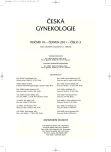-
Medical journals
- Career
Predictors of combined hormone contraception choice between Czech and Slovak women
Authors: Tomáš Fait
Authors‘ workplace: Gynekologicko-porodnická klinika 1. LF UK a VFN, Praha, přednosta prof. MUDr. A. Martan, DrSc.
Published in: Ceska Gynekol 2011; 76(3): 190-193
Overview
Objective:
The aim of the project was to evaluate criterias for women’s contraception application way choice.Design:
Non-interventional, multicentric, prospective project.Setting:
Dept. of Obstetrics and Gynecology, 1st Faculty of Medicine, Charles University Prague.Methods:
The choice of application way of combined hormone contraception was evaluate in group of 1944 women in 183 centers before and after doctor’s consultation. Women’s opinions, knowledges and socio-demografic predictors were corelated with final decision.Results:
The most important factor choice of application way is minding that application is easy. It elevates probability of final choice by 65% for combined oral contraception and by 90% for path and vaginal ring. Vote for vaginal ring and patch is growing with age.Conclusions:
Easibility of application, efficacy and cycle control are the most important predictors for contraception choice. The biggest fears are connected with adverse events for pills and low frequency of usage in population for patch and ring.Key words:
combined hormonal contraception, pill, vaginal ring, patch, CHOICE project, criteria for choice.
Sources
1. Draper, L. Working women and contraception. AAOHN J, 2006, 54, p. 2304-2311.
2. Fait, T. Význam konzultace při výběru kombinované hormonální antikoncepce – výsledky studie CHOICE v České a Slovenské republice. Čes Gynek, 2011, 76, 2, s. 140-144.
3. Fiebig, DG., Knox, S., Vinex, R., et al. Preferences for new and existing contraceptive products. Health Econ, 2010, Epub ahead of print.
4. Lete, I., Doval, JL., Perez-Campos, E., et al. Factors affecting women’s selection of a combined hormonal contraceptive method: the TEAM-06 Spanish cross-sectional study. Contraception, 2007, 76, p. 77-83.
5. Lopez, LM, Steiner, MJ., Grimes, DA., Schulz, KF. Strategies for communication contraceptive effectiveness. Cochrane Database Syst Rev, 2008, 16, 2, CD006964.
6. May, WL., Johonson, WD. A SAS macro for constructing simultaneous confidence intervals for multinomial proportions. Computer methods and programs. Biomedicine, 1997, 53, p. 153-162.
7. Skouby, SO. Contraceptive use and behavior in the 21st century: a comprehensive study across five European countries. Eur J Contracept Reprod Health Care, 2004, 9, 2, p. 57-68.
8. Urdl, W., Apter, D., Alperstein, A., et al. Contraceptive efficacy, compliance and beyondfactors related to satisfaction with once-weekly transdermal compared with oral contraception. Eur J Obstet Gynecol Reprod Biol, 2005, 121, p. 202-210.
Labels
Paediatric gynaecology Gynaecology and obstetrics Reproduction medicine
Article was published inCzech Gynaecology

2011 Issue 3-
All articles in this issue
- Primary drug resistance/sensitivity in vitro and clininical outcome in ovarian cancer patients
- Predictors of combined hormone contraception choice between Czech and Slovak women
- Prognostic importance of selected molecular genetic immunohistochemical markers and DNA ploidy in endometrial cancer
- Psychosocial factors influencing the perinatal health care satisfaction of parturients
- Spontaneous preterm birth in mother in an artificial sleep on ECMO with severe form of H1N1 infection
-
Guideline gynekologických zhoubných nádorů 2010
Primární chirurgická léčba zhoubných nádorů endometria - Risk-reducing surgery in women at hereditary risk of gynaecological cancer
- Biophysical methods in diagnosis of intrapartal fetal hypoxia
- Advanced maternal age as a sole indication for amniocentesis – analysis of 418 fetal karyotypes
- High resistance of bacterial strains Streptococcus agalactiae to antibiotic therapy in early-onset and late-onset disease in newborns
- Optimization of antibodies examanination against thrombocytes in pregnant and postpartum women
- Hereditary susceptibility to endometrial cancer
- The role of hysterectomy in management of cervical precancer lesions
- Czech Gynaecology
- Journal archive
- Current issue
- Online only
- About the journal
Most read in this issue- High resistance of bacterial strains Streptococcus agalactiae to antibiotic therapy in early-onset and late-onset disease in newborns
- Optimization of antibodies examanination against thrombocytes in pregnant and postpartum women
- Biophysical methods in diagnosis of intrapartal fetal hypoxia
- The role of hysterectomy in management of cervical precancer lesions
Login#ADS_BOTTOM_SCRIPTS#Forgotten passwordEnter the email address that you registered with. We will send you instructions on how to set a new password.
- Career

